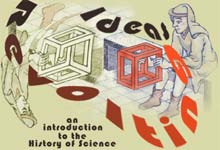
University of California, Irvine
Instructor: Dr. Barbara J. Becker

|
Week 7. Natural Forces an adapted excerpt from
|
|
It often happens that everyday occurrences cause us to think about some of the most curious operations of Nature. Very interesting experiments can often be made, almost without trouble or expense, by means of equipment designed for other purposes. I am persuaded that a habit of keeping the eyes open to everything that is going on in the ordinary course of the business of life has very often led to useful doubts and sensible schemes for investigation. Being engaged lately in superintending the boring of cannon in the workshops of the military arsenal at Munich, I was struck with the very considerable degree of Heat which a brass gun acquires in a short time in being bored, and with the still more intense Heat (much greater than that of boiling water) of the metallic chips separated from it by the borer. The more I thought about these phenomena, the more they appeared to me to be curious and interesting. A thorough investigation of them seemed to promise a farther insight into the hidden nature of Heat, and to enable us to form some reasonable ideas concerning the existence, or non-existence of an igneous fluid,-- a subject on which philosophers have disagreed for centuries. I wondered about where the Heat comes from that is actually produced while boring a cannon. Is it supplied by the metallic chips which are separated by the borer from the solid mass of metal? Did it come from the surrounding air? I devised a series of experiments to find out for sure. A blunt steel borer was placed in a hollow brass cylinder. A water-tight wooden box was placed around this apparatus. The box was filled with cold water (at a temperature of 60°) and the machinery was put into motion by the force of two horses. The result of this beautiful experiment was very striking, and the pleasure it afforded me amply repaid me for all the trouble I had had in contriving and arranging the complicated machinery used in making it. The cylinder, revolving at the rate of about 32 times in a minute, had been in motion but a short time, when I perceived, by putting my hand into the water and touching the outside of the cylinder, that Heat was generated. It was not long before the water which surrounded the cylinder began to feel warm.
The cannon and machinery used in Count Rumford's cannon-boring experiment to measure the quantity of heat made by friction. At the end of 1 hour I found, by plunging a thermometer into the water in the box, that its temperature had been raised no less than 47 degrees! When 30 minutes more had elapsed, the Heat of the water in the box was 142°. At the end of 2 hours from the start of the experiment, the temperature of the water was found to be raised to 178°. At 2 hours 20 minutes it was at 200°; and at 2 hours 30 minutes it ACTUALLY BOILED! I cannot begin to describe the surprise and astonishment expressed in the faces of the bystanders, on seeing so large a quantity of cold water heated, and actually made to boil, without any fire. Though there was, in fact, nothing that surprised me about this event, I have to admit that it afforded me a degree of childish pleasure. So, what is Heat? Is there any such thing as an igneous fluid? Is there anything that can be called caloric? We have seen that a large amount of Heat may be excited in the friction of two metallic surfaces, and given off in a constant stream in all directions without interruption and without any signs of exhaustion. Where does this Heat come from? Was it furnished by the small particles of metal detached from the larger solid mass? Was it furnished by the air? Was it furnished by the water which surrounded the machinery? Anything which can be produced in endless supply cannot possibly be a material substance. It appears to me to be extremely difficult, if not quite impossible, to imagine anything capable of being excited and communicated in the manner the Heat was excited and communicated in these experiments, except it be MOTION. I am very far from pretending to know how, or by what means that particular kind of motion is excited, continued, and spread. But, although the mechanism of Heat should, in fact, be one of those mysteries of nature which are beyond the reach of human intelligence, this ought not to discourage us in our attempts to investigate the laws of its operation. |
|